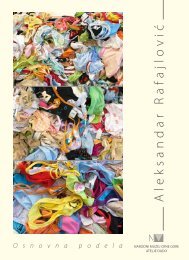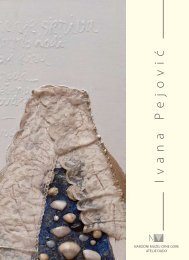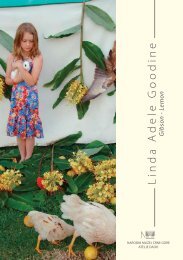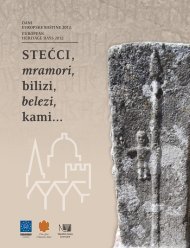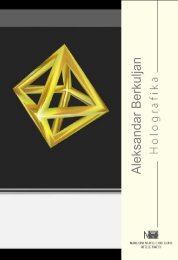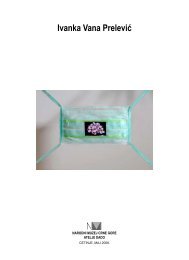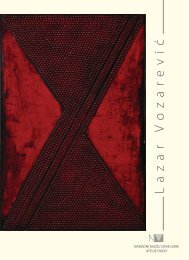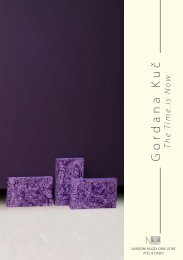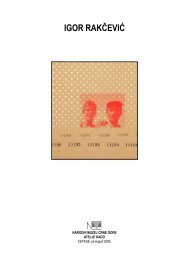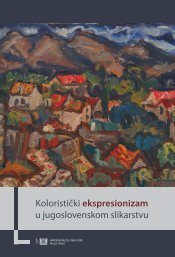Milena MartinoviÄ - Narodni muzej Crne Gore
Milena MartinoviÄ - Narodni muzej Crne Gore
Milena MartinoviÄ - Narodni muzej Crne Gore
Create successful ePaper yourself
Turn your PDF publications into a flip-book with our unique Google optimized e-Paper software.
“When you look at his drawings, they look like maps, which is unusual for a sculptor. These contours do<br />
not make shapes; they simply mark borders you can cross. All these works are about leaving. Mostly<br />
about leaving the earth and going to the sky, which his Columns-without-end, do.” John Berger on Constantin<br />
Brancusi<br />
A similar feeling of abandonment of the real space can be observed in the works of <strong>Milena</strong> Martinovic.<br />
The long process of reducing an idea to a simple shape is realized on paper as a contour, a frame that implies<br />
form. In questioning these relations toward herself and perceiving the process of creative moment,<br />
she reaches for memories from her childhood, recalling suppressed emotions and earliest experiences.<br />
Looking for a simple way in which to materialize something transient, neutral or almost invisible and yet<br />
more complex structure, she has found a concrete shape in nature, in the leaf of the plant Lunaria. Specific<br />
elliptical form, translucent, almost nacreous, has become the model for developing this creative act.<br />
Following the changes in the plant’s life cycles (withering, seeding, decomposing and growing again),<br />
<strong>Milena</strong> indirectly reconsiders her own changes, by questioning the meaning of her own existence in a<br />
wider context, and her place on a cosmic map, seen through the act of creation.<br />
Constructing a “specific personal world” in which this leaf represents the nucleus, and not just the padding,<br />
<strong>Milena</strong> creates hermetic microcosm, known only to her, whose function is based on the principles<br />
of nature, adapting to its iconic rhythms of becoming and disappearing, while trying at the same time to<br />
maintain the authenticity of personal artistic language.<br />
The chosen motive has variations, and has been adapted to the technique and materials; in some drawings<br />
there are many visible layers, overlapping and peaking through, in others with the force of a pendulum,<br />
the size of the ellipse is proportionally magnified, depending on the format, while the installation<br />
contains the strongest feeling of energy in the translucent light of a fragile leaf. Modulating the methods<br />
of building concatenations the thickness also varies, but the shape remains always the same. Sometimes,<br />
some parts of the ellipses are additionally emphasized, creating new layer and compact web that<br />
protects the thin structures of the oval shapes. Often, graduated pastels or halftone-hues colour parts<br />
overlap, amplifying the contours and creating new assemblages with strong inner spaces. Exactly this<br />
concrete shape by eliminating its primary meaning, gains the importance, and becomes flexible as appearance,<br />
equally strong as a sign, a form or material.<br />
“Art is particular way in our daily practice of manifestation in which we recognize ourselves and all that<br />
surround us” - Gerhard Richter.<br />
The treatment of material is completely different when used in the installation. <strong>Milena</strong> respects the natural<br />
logic of the substance, creating a distinctive kind of mobile sculpture, very light, mobile spiral made<br />
from dried leaves fixed in such a precise way as if they were made by an filigree. We come again to<br />
Brancusi’s endless column, which although limited in height emanates energy as if it had no end. Its monumentality<br />
becomes the metaphor for the absolute. Moving from the static, which could be expected from<br />
such a massive form, towards the absolute dynamics of shapes due to the light elements, it emanates<br />
the motion, latent tension, recalling the feeling that Robert Smithson’s calls “metaphysical archaeology”,<br />
energy of the ground. There is no epicenter, nor center of the action, it looks like it has been torn off from<br />
an endless chain, a secret DNA, we know resides within this structure, but we cannot see. That inscription,<br />
a magical “genetic code” can directly relate to the artists’ personal code. The form is recognizable,<br />
the shape is real but although visible the seeds under the membrane are not easy to be reached.<br />
Just the same is <strong>Milena</strong>s’ code - at first sight explicit and simple, but again quite hidden and hermetic.<br />
And all this can be understood as an attempt to decipher it.<br />
Mirjana Dabović Pejović



